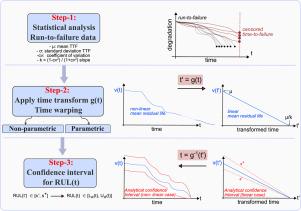基于时间变换的规则规则动力学与不确定性分析
IF 11
1区 工程技术
Q1 ENGINEERING, INDUSTRIAL
引用次数: 0
摘要
本文介绍了一种新的分析方法来分析剩余使用寿命(RUL)的动态,并量化其估计中的不确定性。该方法采用时间变换,使平均剩余寿命(MRL)成为变换时间的线性函数,从而能够推导出明确的RUL置信界限。一旦映射回物理空间,边界量化RUL中的任意(随机)不确定性,并产生参数和非参数寿命分布的不对称置信区间。该方法利用了可靠性分布的一个关键特征:转换时间内的平均RUL损失率k,便于直接推导置信界限。在参数情况下,k是由可靠性分布参数唯一定义的,而对于非参数分布,k是通过估计变异系数从数据中导出的。坡度越大,表明退化速度越快,导致置信区间越窄,RUL方差越小。对该方法在随机过程中的适用性和不同数据量下的鲁棒性进行了研究和讨论。这种新颖的方法揭示了迄今为止对经典可靠性分布的未知见解。通过实际应用,包括LED可靠性评估、并行系统RUL估计和使用NASA N-CMAPSS数据的涡轮风扇寿命预测,为平均剩余寿命和剩余使用寿命的演变动态提供了新的视角。本文章由计算机程序翻译,如有差异,请以英文原文为准。

Analysis of RUL dynamics and uncertainty via time transformation
This work introduces a novel analytical method to analyze the dynamics of remaining useful life (RUL) and quantify uncertainty in its estimation. The approach employs a time transformation that makes the mean residual life (MRL) a linear function of transformed time, enabling the derivation of explicit RUL confidence bounds. Once mapped back to physical space, the bounds quantify aleatoric (stochastic) uncertainty in RUL and yield asymmetrical confidence intervals for both parametric and non-parametric lifetime distributions. The approach leverages a key feature of reliability distributions: the average RUL loss rate, , in transformed time, facilitating a direct derivation of confidence bounds. In parametric cases, is uniquely defined by the reliability distribution parameters, while for non-parametric distributions, it is derived from data by estimating the coefficient of variation. Higher slopes indicate faster degradation, leading to narrower confidence intervals and lower RUL variance. The method’s applicability to stochastic processes and robustness under different data volumes are also investigated and discussed. The novel approach reveals heretofore unknown insights into classical reliability distributions. It is demonstrated through real-world applications, including LED reliability assessment, parallel system RUL estimation, and turbofan lifespan prediction using NASA N-CMAPSS data, offering a new perspective on the evolving dynamics of mean residual life and remaining useful life.
求助全文
通过发布文献求助,成功后即可免费获取论文全文。
去求助
来源期刊

Reliability Engineering & System Safety
管理科学-工程:工业
CiteScore
15.20
自引率
39.50%
发文量
621
审稿时长
67 days
期刊介绍:
Elsevier publishes Reliability Engineering & System Safety in association with the European Safety and Reliability Association and the Safety Engineering and Risk Analysis Division. The international journal is devoted to developing and applying methods to enhance the safety and reliability of complex technological systems, like nuclear power plants, chemical plants, hazardous waste facilities, space systems, offshore and maritime systems, transportation systems, constructed infrastructure, and manufacturing plants. The journal normally publishes only articles that involve the analysis of substantive problems related to the reliability of complex systems or present techniques and/or theoretical results that have a discernable relationship to the solution of such problems. An important aim is to balance academic material and practical applications.
 求助内容:
求助内容: 应助结果提醒方式:
应助结果提醒方式:


